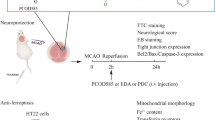Abstract.
The modulation of the enhanced release of [3H]glutamate following ischemia-like conditions was studied in rat hippocampal slices using a superfusion system. Ischemia was simulated by a glucose-free medium equilibrated with 95% N2 and 5% CO2. In this model the potential neuroprotective effects of several substances on [3H]glutamate release induced by ischemia-like conditions were investigated. Gabapentin-lactam (8-aza-spiro-5,4-decan-9-on; GBP-L) was synthesised and patented in our laboratory. GBP-L (100 µM) reduced the oxygen glucose deprivation-induced [3H]glutamate release by 42.5%, CI95=[33.4%, 51.5%]. The KATP channel antagonist glibenclamide (1 µM) blocked this effect completely. The high antagonist potency was reflected by an apparent pA 2-value of glibenclamide of 8.3, CI95=[6.8, 9.4]. Minoxidil sulfate (10 µM), a KATP channel opener, mimicked the effect of GBP-L (inhibition by 22.8%, CI95=[13.2%, 32.5%]). Similarly to its lactam, also gabapentin (100 µM) reduced the oxygen glucose deprivation-induced [3H]glutamate release by 30.6%, CI95=[15.5%, 45.7%], whereas the "antiglutamatergic" drug riluzole was ineffective.
GBP-L and gabapentin were also tested in an in vivo model of acute retinal ischemia in rats. The intraocular pressure was elevated for 1 h above the systolic blood pressure. In the control group, 17.5%, CI95=[13%, 22%], of retinal ganglion cells had survived after 2 weeks. GBP-L doubled the number of surviving ganglion cells up to 35%, CI95=[27%, 43%], while gabapentin had no effect. This difference between gabapentin and its lactam may be due to different pharmacokinetic properties: In contrast to the γ-amino acid gabapentin, GBP-L is uncharged and therefore might diffuse more easily through biological membranes, e.g. the plasma membrane, to get access to an intracellular locus of action.
Thus, the neuroprotective properties in vivo and the diminished oxygen glucose deprivation-induced [3H]glutamate efflux in vitro of the presumed KATP channel agonist GBP-L suggest that this substance might be therapeutically applied in pathological situations induced by a rise in extracellular glutamate and/or neuronal cell death.
Similar content being viewed by others
Author information
Authors and Affiliations
Additional information
Electronic Publication
Rights and permissions
About this article
Cite this article
Jehle, T., Lagrèze, W., Blauth, E. et al. Gabapentin-lactam (8-aza-spiro[5,4]decan-9-on; GBP-L) inhibits oxygen glucose deprivation-induced [3H]glutamate release and is a neuroprotective agent in a model of acute retinal ischemia. Naunyn-Schmied Arch Pharmacol 362, 74–81 (2000). https://doi.org/10.1007/s002100000265
Received:
Accepted:
Issue Date:
DOI: https://doi.org/10.1007/s002100000265




